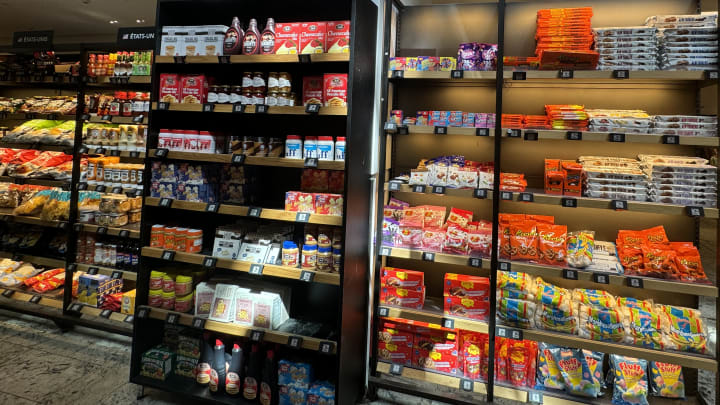This Is What the American Section of a Fancy French Grocery Store Looks Like

PARIS — It’s important to see the sites when you are traveling, so after checking out the Eiffel Tower and the Picasso Museum, I recently made my way to my favorite Paris landmark: the American food section of the city’s fanciest grocery store.
La Grande Épicerie, about a mile east of where archery is being contested at the complex that houses Napoleon’s tomb, is the grocery store attached to Le Bon Marché, a high-end department store owned by LVMH, which also owns Louis Vuitton, Moet-Hennessy and Tiffany.
La Grande Épicerie mostly matches its LVMH siblings in luxury, from the multiple foie gras refrigerators to the cheese counter that almost needs its own postcode. Near the produce stands a series of shelves housing international foods. Italy: pasta, tomato sauce, biscotti. Japan: nori, rice crackers, miso paste. Canada: maple syrup, maple jelly, maple sugar.
In the center lurks the United States, represented here by what the French seem to believe to be our national delicacies: Reese’s, marshmallow fluff and two varieties of corn syrup. There are also half a dozen types of microwave popcorn, sour candy, off-brand boxed macaroni and cheese, jars of “hot-dog sausages” and Hershey’s cookies and cream bars.
Again, this is a gourmet grocery store.
As an American, I am offended. As a journalist, I am intrigued.
I stop by this area nearly every time I am in the city, hoping to see someone purchase something so I can ask why, but I have never been lucky. Until today, when within a few minutes of lurking I caught sight of a young French woman plucking a package of Reese’s dipped pretzels from the shelf. I pounced.
“It’s a mix of sweet and salty, and Americans love sweet and salty,” Juliette Sabater, who works in marketing, explains in French. Most of what is on offer here is too sweet for her, she adds.
Yes, that is our primary reputation abroad, and it’s earned: According to a 2015 study by the market research firm Euromonitor, Americans average more than 126 grams of sugar per day, nearly twice the French intake—and more than twice the World Health Organization’s recommendation.
We are perhaps not helping our cause right now with the Krispy Kreme ads throughout the Paris Metro system that bear a photo of a donut with a bite taken out of it, making it look crescent-shaped, and the caption: The best croissant in Paris.
Meanwhile, two American tourists, teachers in New Jersey, are walking by and chuckling about the selection. “It’s all crap,” says Michael Fleming with a laugh. He adds that when he spent time in the United Kingdom, he noticed that locals were very interested in chocolate syrup and brown sugar. But at least those are ingredients. These are finished products, although it’s hard to imagine finishing some of them.
“I think it’s kind of strange,” says Katie Laurino. “I don’t wish I had some ‘hot-dog sausages’ in a jar.”
Cécile Irtelli, who helps select the products for the U.K. section—mostly teas, although they also get a dozen varieties of shortbread and a few other desserts—insists that that attitude is the minority.
“These are very popular,” she says in French. “We have French people who come from all over France. You can’t find these products elsewhere.” Beef jerky, she says, drives people especially mad. “We don’t have it at all in France.”
French people understand that there is more to American food than partially hydrogenated soybean oil, explains Christy Shields, an associate professor of anthropology at the American University of Paris who specializes in the study of food. But “you still have the stereotype that Americans eat a bunch of junk and they eat a lot of it.” (Speaking of stereotypes, I also emailed an associate professor who teaches a food culture class at the Sorbonne. Her autoreply promised to get back to me some time in September.)
As more French people travel to the United States—at any given moment there seems to be more French than English spoken in Central Park—they return with an appreciation for what they have eaten there, and they bring it back with them. “There are a growing number of Mexican-American restaurants,” Shields says. “There’s a fascination with soul food. There are burgers in every restaurant and café now.” And another American import has taken hold: “Oh my God,” she says. “The brunch.”
Some of our cultural quirks have been less successful. I tell Irtelli the story of when I studied abroad here and my host family welcomed me with a small jar of peanut butter (bought at a sadly defunct American food store called Thanksgiving). Their only request: that I not defile their jelly with it. Irtelli gasps at the very idea.
But Shields was delighted when she recently learned of a store a mile and a half east of La Grande Épicerie called COW: Cheese of the World. It stocks a wonderful chèvre from Vermont. “I was so happy to find an American product that was artisanal,” she says.
Those are in short supply at La Grande Épicerie. The closest thing I find to a mom-and-pop producer is Paul Newman’s ranch dressing. While I am investigating it, Sabater reconsiders her purchase. She returns the Reese’s pretzels. Instead she selects what appears to me to be an almost identical product by Flipz—from the U.K. section.
